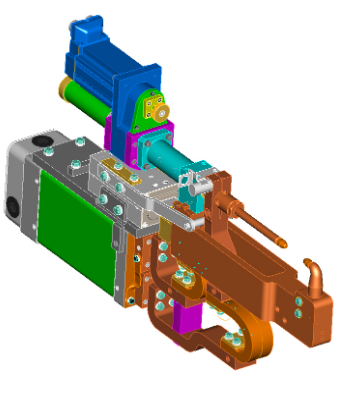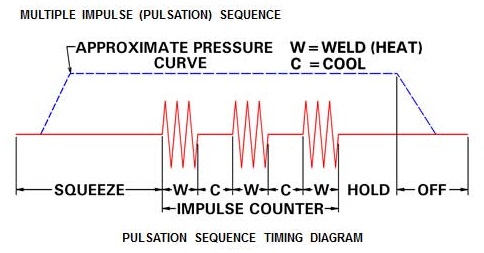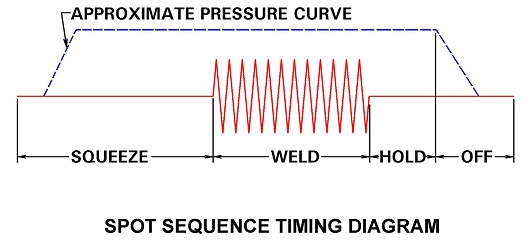
Spot Welding
Questions and Answers
In the current market there are three systems used to deliver force on new resistance welders. They are air cylinders, air over oil cylinders and servos. In the marketplace I could probably find foot operated, cam and spring-operated devices still in use. New equipment is using cylinders and servos.
Pneumatic air cylinders have been around for many years and are well know in terms of design, capabilities and maintenance. They are used in all applications. They are noisy and require an air supply. In a large facility air has a cost.

GUN WITH AIR CYLINDER
Air over oil offers a soft touch and higher pressures in comparibly small cylinder sizes. Used for most applications including presses and weld guns. It does require both air and oil systems.

AIR OVER OIL CYLINDER
Servo offers computer style control, quiet and no need for large volume of air in the plant. Robotic systems have moved toward servos. Some press welders have used servos.

SERVO ACTUATED GUN
To learn why force is important in resistance welding see article:
WHAT IS THE FORCE COMPONENT OF A WELD SCHEDULE?
References: RWMA Resistrance Welding Manual 4th Edition
Some ARTWORK courtesy of Centerline
Pulses are used in resistance welding to help grow the nugget size without overheating the part. It is difficult to grow a nugget as large as the electrode face diameter or larger without being inventive with the weld schedule. Pulses or impulses are one means of obtaining nugget growth without overheating the part. There is always one or two off/cool cycles between each pulse.

Additional information on pulsation can be found in another article in this blog:
WHEN USING PULSATION IS THE SECOND PULSE SET HIGHER OR LOWER THAT THE FIRST PULSE?
Reference: RWMA - Resistance Welding Manual 4th Edition
WHEN USING PULSATION IS THE SECOND PULSE SET HIGHER OR LOWER THAT THE FIRST PULSE?Reference: RWMA - Resistance Welding Manual 4th Edition
On all welders the tongs should mate at the weld surface when the electrodes are attached. Altering the bend without or with heat might be a solution. Keep in mind the heat may anneal the tongs and reduce their strength. Good quality equipment has adjustments for alignment.
This is a machinery design/warranty issue not a resistance welding issue. It is not in the scope of this blog.
Many components in a resistance welding machine should see 4-6 L per minute (1-1.5 gal/min) of water. This is a very high necessary flow of cool water. The specifications for this water can be found in:
AWS Specification AWS J1.2 Guide to Installation and Maintenance of Resistance Welding Machines
Proper sizing of the electric, air and water for a welder installation is very important. It should be done by professionals. The machine manufacturer may provide specifications for the installation. Contact local qualified installers.
This subject is beyond the scope of the blog.

Reference: American Welding Society - AWS J1.2 Guide to Installation and Maintenance of Resistance Welding Machines
An inquiry came in after reading about PCT, It asked when does current flow? To clarify current flows during weld time. Be it AC, DC or MFDC equipment. Weld time is when the current is ON. The current is on the length of time T of PCT. The amplitude of the current is C of PCT. By now you know that the pressure or force is P of PCT.

To see and understand this better please view another article in this blog:
HOW ARE PRESSURE CURRENT AND TIME USED IN RESISTANCE WELDING?
Reference: RWMA Resistance Welding Manual 4th Edition
Page 3 of 47
Have a Question?
Do you have a question that is not covered in our knowledgebase? Do you have questions regarding the above article? Click here to ask the professor.
